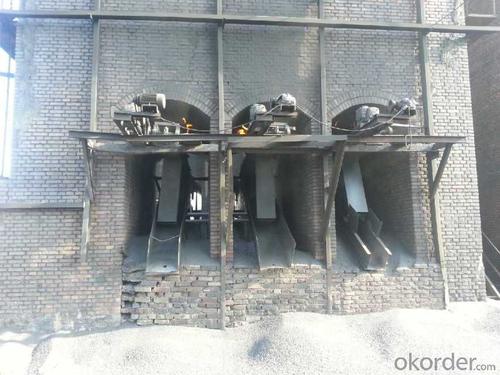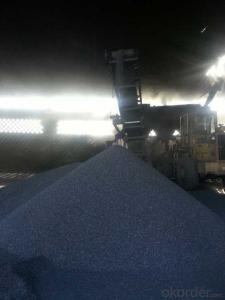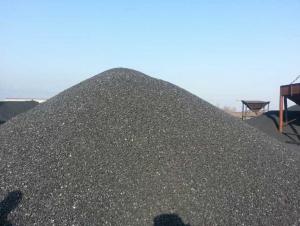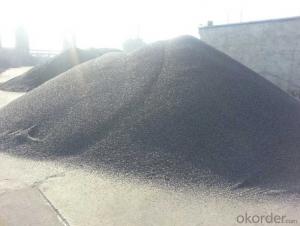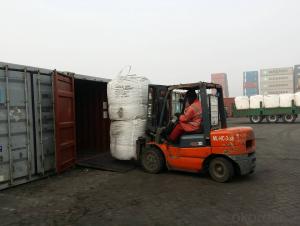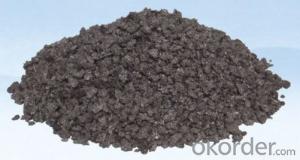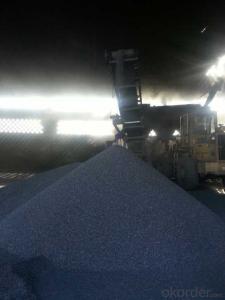Calcined Anthracite FC90-95 With High Quality
- Loading Port:
- Lianyungang
- Payment Terms:
- TT OR LC
- Min Order Qty:
- 20 m.t.
- Supply Capability:
- 3500 m.t./month
OKorder Service Pledge
OKorder Financial Service
You Might Also Like
Calcined Anthracite FC90-95
Packaging & Delivery
25kgs/50kgs/1ton per bag or as buyer's request
Features
Calcined Anthracite
Fixed carbon: 90%-95%
S: 0.5% max
Size: 0-3. 3-5.3-15 or as request
It used the high quality anthracite as raw materials through high temperature calcined at over 2000 by the DC electric calciner with results in eliminating the moisture and volatile matter from anthracite efficiently, improving the density and the electric conductivity and strengthening the mechanical strength and anti-oxidation. It has good characteristics with low ash, low resistvity, low sulphur, high carbon and high density. It is the best material for high quality carbon products.
Advantage and competitive of caclined anthracite
1. strong supply capability
2. fast transportation
3. lower and reasonable price for your reference
4.low sulphur, low ash
5.fixed carbon:95% -90%
6..sulphur:lower than 0.3%
General Specification of Calcined Anthracite
| FC | 95 | 94 | 93 | 92 | 90 |
| ASH | 4 | 5 | 6 | 6.5 | 8.5 |
| V.M. | 1 | 1 | 1 | 1.5 | 1.5 |
| S | 0.3 | 0.3 | 0.3 | 0.35 | 0.35 |
| MOISTURE | 0.5 | 0.5 | 0.5 | 0.5 | 0.5 |
Pictures

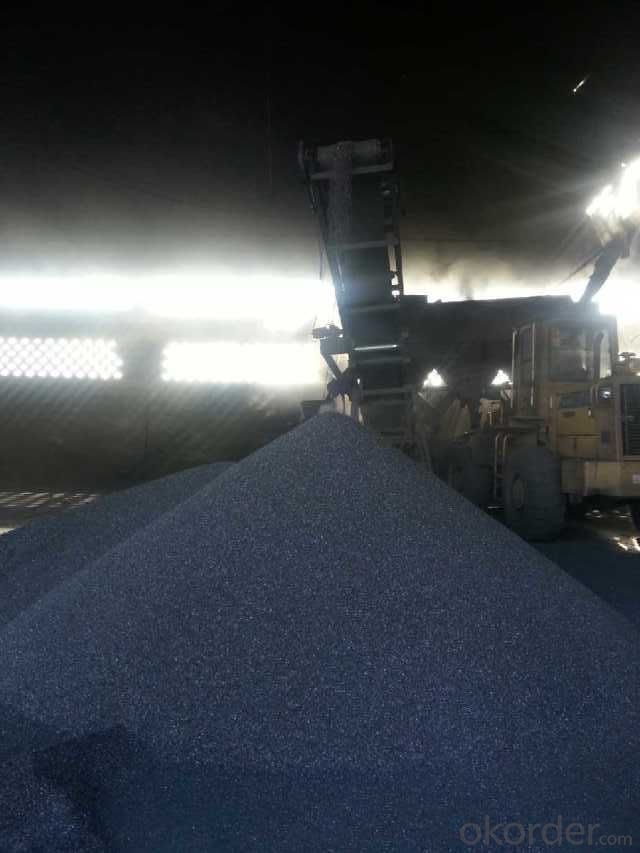
- Q: How does carbon form?speed
- How is coal formed?Coal is known as black gold, the food industry, it is one of the main energy use of the human world since eighteenth Century. Although its important position has been replaced by oil, but in the future for a long period of time, due to the exhaustion of petroleum, inevitable decline, but because of the huge reserves of coal, and the rapid development of science and technology, the new technology of coal gasification is becoming more mature and widely used, coal will become one of the production and life of human beings in an irreplaceable energy.Coal is millions of years of plant leaves and roots, stacked on the ground with a layer of very thick black humus, due to changes in the earth's crust constantly buried underground, long isolated from the air and under high temperature and pressure, after a series of complex physical and chemical changes and other factors, the formation of black however, this fossil, is the coal forming process.The thickness of coal seam in a coal mine and the crust drop speed and accumulation amount of plant remains. The crust decreased rapidly, the plant remains piled thick, the coal seam is thick, on the other hand, the crust decline slowly, the accumulation of plant remains thin, the mine coal seam is thin. The tectonic movement of the crust to the original level of coal seam folds and faults occur, some underground coal seam buried deeper, and squeezed to the surface, even above the ground, more likely to be found. There are some relatively thin coal seam, and the area is not large, so there is no value related to the formation of coal mining, so far not find the update statement.
- Q: How does a kebab cook at home?
- Do you have long fire sticks in your house?...... Yes, just a carbon and burn it over the gas stove...... If not, apply a little oil underneath......Burn, put carbon on the top, pay attention to leave the gap, do not suppress it.
- Q: How does carbon impact soil health?
- Carbon plays a crucial role in maintaining and improving soil health. It is a key component of organic matter, which is essential for fertile and productive soils. When carbon is added to the soil through the decomposition of plant and animal residues, it helps to improve the soil structure, water holding capacity, and nutrient availability. One of the primary ways carbon impacts soil health is through its ability to enhance soil structure. Carbon binds with soil particles to form aggregates, which create pore spaces in the soil. These pore spaces allow for better aeration, water infiltration, and root penetration. Good soil structure promotes the growth of beneficial soil organisms like earthworms and microorganisms, which further contribute to soil health. Carbon also plays a crucial role in improving the water holding capacity of soils. Organic matter, rich in carbon, acts as a sponge by holding moisture and preventing water runoff. This is particularly important in arid or drought-prone regions where water scarcity is a concern. Improved water retention in soils not only helps plants withstand dry periods but also reduces erosion and nutrient leaching. Furthermore, carbon is a vital nutrient for soil microbes. Microorganisms, such as bacteria and fungi, break down organic matter, releasing nutrients that are essential for plant growth. Carbon-rich soils provide a favorable environment for these microorganisms to thrive, leading to increased nutrient availability for plants. Additionally, as microorganisms decompose organic matter, they release beneficial substances like enzymes and hormones that further support plant growth and overall soil health. In conclusion, carbon greatly impacts soil health by improving soil structure, enhancing water holding capacity, and promoting nutrient availability. Therefore, managing and increasing carbon content in soils through practices like adding organic amendments, cover cropping, and reducing tillage can greatly benefit agricultural productivity and sustainability.
- Q: How does carbon occur in nature?
- Various forms of carbon occur naturally in nature and it is one of the most abundant elements on Earth. It can be found in the atmosphere, the Earth's crust, and living organisms. In the atmosphere, carbon primarily exists as carbon dioxide (CO2), which is produced through natural processes like respiration, volcanic activity, and the decay of organic matter. Plants absorb this CO2 during photosynthesis to generate energy and release oxygen. Carbon is also present in other greenhouse gases like methane (CH4), which is produced by natural processes such as the decomposition of organic matter in wetlands and the digestive processes of certain animals. In the Earth's crust, carbon is present in various minerals like limestone, dolomite, and graphite. These minerals form over millions of years through the accumulation of marine organisms, such as shells and skeletons. Carbon is also a vital component of fossil fuels like coal, oil, and natural gas, which are formed from the remains of ancient plants and animals subjected to high pressure and temperature over time. Additionally, carbon is an essential element for all living organisms and serves as the foundation of organic chemistry. It is the primary component of organic matter, including carbohydrates, proteins, lipids, and nucleic acids, which are the building blocks of life. Through processes like photosynthesis, respiration, and decomposition, carbon cycles continuously within ecosystems. In conclusion, carbon occurs naturally in different forms in the environment and plays a critical role in the Earth's climate system, geological processes, and the sustenance of life.
- Q: How can individuals reduce their carbon footprint?
- Achieving a more sustainable future and reducing our carbon footprint can be accomplished through various actions. Consider the following effective methods: 1. Energy consumption reduction: The conservation of energy plays a vital role in decreasing carbon emissions. Make the switch to energy-efficient appliances, turn off lights when not in use, unplug electronics when not in use, and take advantage of natural lighting whenever possible. Additionally, adjusting thermostats to energy-saving temperatures and utilizing programmable thermostats can significantly decrease energy consumption. 2. Utilize renewable energy sources: A transition to renewable energy sources, such as solar or wind power, can drastically reduce carbon emissions. Install solar panels on rooftops, or explore the option of purchasing green energy from utility companies that provide renewable alternatives. 3. Decrease water usage: Indirectly, conserving water aids in reducing energy consumption and carbon emissions. Repair leaky faucets, shorten shower durations, install water-saving fixtures, and gather rainwater for outdoor activities. Additionally, consider implementing drought-resistant landscaping to minimize water usage for gardening purposes. 4. Consume mindfully: When making purchases, opt for sustainable choices. Select durable and long-lasting items, repair and reuse rather than replacing, and prioritize products made from recycled or sustainable materials. Furthermore, support local and sustainable businesses that prioritize eco-friendly practices. 5. Minimize transportation emissions: Reduce reliance on private vehicles by utilizing public transportation, carpooling, biking, or walking whenever feasible. If owning a car is necessary, choose electric or hybrid vehicles. Regular maintenance, proper tire inflation, and avoiding unnecessary idling all contribute to decreasing transportation emissions. 6. Embrace a plant-based diet: The food industry has a considerable carbon footprint, particularly due to livestock production. By reducing meat consumption or adopting a plant-based diet, carbon emissions can be significantly reduced while also offering health benefits. If a complete plant-based diet is not feasible, try incorporating more vegetarian or vegan meals into your eating habits. 7. Decrease waste generation: Waste contributes to greenhouse gas emissions, making waste reduction crucial. Opt for products with minimal packaging, diligently recycle, compost organic waste, and avoid single-use plastics. Plan meals, only purchase what is needed, and properly store leftovers to minimize food waste. 8. Support environmental initiatives and organizations: Engage with local and global organizations dedicated to environmental conservation. Take part in community clean-ups, support reforestation efforts, and advocate for sustainable practices in your workplace and community. By implementing these strategies into our daily lives, individuals can make a significant impact in reducing their carbon footprint and combating climate change. It is important to remember that every small action matters, and collectively, we can create a sustainable future for future generations.
- Q: How do you use carbon fourteen to measure the age?
- One is obvious a small amount of sample, only 1 ~ 5 mg samples can be, such as a piece of fabric, bone chips, toner trace of ancient ceramics in the surface or pores can be measured; while the conventional carbon - 14 dating rules 1 to 5 grams of samples differ by 3 orders of magnitude. The two is high sensitivity. The sensitivity of 10-15 to 10-16 isotope ratio measurement; while the conventional carbon - 14 dating rules with a difference of 5 to 7 orders of magnitude. Three is a short measurement time, measurement of modern carbon to reach 1% accuracy, only 10 to 20 minutes; while the conventional carbon - 14 dating is 12 ~ 20 hours. It is due to carbon - 14 accelerator mass spectrometry dating method has the advantage, since its inception, has been paid attention to by archaeologists, paleontologists and geologists, and is widely used. It can be said that within 50000 years of cultural relics on the determination of samples, carbon - 14 accelerator mass spectrometry dating method is determined the accuracy of a maximum of 1. carbon. 14 is a radioactive isotope of carbon, was found in 1940. It is produced by cosmic rays collide with a nitrogen atom in the air, which has a half-life of about 5730 years, as the decay of beta decay, 14 atoms into carbon nitrogen atoms.
- Q: What is carbon nanocomposite coating?
- Carbon nanocomposite coatings, composed of carbon nanotubes or other carbon-based nanoparticles dispersed within a matrix material like polymer or metal, serve as a protective coating for diverse surfaces. The primary goal of these coatings is to enhance the mechanical, thermal, and electrical properties of the material being coated. By incorporating carbon nanoparticles, the coating gains strength, hardness, and wear resistance, resulting in increased durability. Furthermore, it exhibits exceptional resistance to corrosion, making it suitable for use in severe environments. A key advantage of carbon nanocomposite coatings lies in their ability to offer multifunctional properties. For instance, they can be engineered to possess high electrical conductivity, making them ideal for electronics and electrochemical devices. Additionally, they can exhibit high thermal conductivity, making them valuable for dissipating heat in electronic devices or as a thermal barrier coating. Moreover, carbon nanocomposite coatings have demonstrated promising outcomes in various sectors such as aerospace, automotive, energy, and healthcare. In aerospace, they enhance the performance and longevity of aircraft components. In the automotive industry, they provide anti-scratch and self-cleaning capabilities. In energy applications, they improve solar panel efficiency and protect oil and gas pipelines from corrosion. In healthcare, they enable drug delivery, act as antibacterial coatings, and facilitate bio-sensing applications. In summary, carbon nanocomposite coatings offer a wide array of advantages, including enhanced mechanical and electrical properties, corrosion resistance, and multifunctionality. With continuous research and development, these coatings hold immense potential for different industries, providing innovative solutions to address their unique requirements and challenges.
- Q: How does carbon dioxide affect the health of marine organisms?
- Carbon dioxide can have significant impacts on the health of marine organisms. When carbon dioxide is absorbed by seawater, it undergoes a chemical reaction that causes the water to become more acidic. This process is known as ocean acidification. Ocean acidification interferes with the ability of many marine organisms to build and maintain their shells and skeletons. For instance, corals, oysters, and other shellfish rely on calcium carbonate to form their protective structures. However, under more acidic conditions, the availability of carbonate ions decreases, making it harder for these organisms to calcify. This can lead to weakened shells, reduced growth rates, and increased vulnerability to predation and disease. Furthermore, ocean acidification can also disrupt the reproductive and developmental processes of marine organisms. For example, some studies have shown that increased CO2 levels can affect the ability of fish to locate their preferred habitats, find mates, and successfully reproduce. Additionally, some species of fish and invertebrates have been found to exhibit altered behavior and impaired sensory functions under high CO2 conditions. In addition to these direct effects, ocean acidification can also have indirect consequences for marine organisms by disrupting entire ecosystems. For instance, the decline in coral reefs due to reduced calcification can have cascading effects on the whole reef ecosystem, impacting the biodiversity and productivity of these important marine habitats. Overall, the increasing levels of carbon dioxide in the atmosphere are not only contributing to global climate change but also leading to ocean acidification, which poses significant threats to the health and survival of many marine organisms. It is crucial to address and mitigate the causes of carbon dioxide emissions in order to protect the delicate balance of our oceans and the diverse range of species that depend on them for their survival.
- Q: when to use hard carbon, and when to use soft carbon. Neutral charcoal can play what role? Thank you.
- The soft carbon strokes are more black and easier to use. The hard charcoal painted gray, the color is not deep, when painting and sketch paper friction is relatively large, there is a general feeling of rustling, veteran can feel it.Soft charcoal most used in a black or a black screen most places, such as shadow, Terminator...
- Q: How does carbon impact the quality of freshwater systems?
- Freshwater systems can be significantly affected by carbon, with one of the main ways being through the emission of carbon dioxide (CO2). Excess CO2 released into the atmosphere can dissolve in rainwater and form carbonic acid, leading to the acidification of freshwater bodies and a decrease in pH levels, making the water more acidic. The high levels of acidity can have negative consequences for various freshwater organisms, including fish, amphibians, and invertebrates. It can disrupt their reproductive systems, hinder their growth and development, and even result in their death. Additionally, increased acidity can also impact the availability of essential nutrients in the water, further affecting the health and survival of aquatic life. Another impact of carbon on freshwater systems is through the process of eutrophication. Excessive carbon can enter freshwater bodies through runoff from agricultural fields or wastewater treatment plants. This surplus of carbon acts as a nutrient, fueling the growth of algae and other aquatic plants. As these plants multiply, they can form dense mats on the water's surface, blocking sunlight and depleting oxygen levels. The depletion of oxygen can lead to hypoxia, a condition characterized by dangerously low oxygen levels that can result in the death of fish and other organisms. Additionally, the excessive growth of algae can cause algal blooms, which can release toxins into the water, further compromising the quality of freshwater systems. Furthermore, carbon also plays a role in influencing the temperature of freshwater systems. Increased levels of carbon dioxide in the atmosphere contribute to global warming, which raises the overall temperature of the planet. Consequently, freshwater systems may experience higher water temperatures, leading to ecosystem changes. Some species may struggle to adapt to these warmer conditions, while invasive species, for example, may thrive. In conclusion, carbon exerts a significant influence on the quality of freshwater systems. It can result in acidification, eutrophication, and temperature changes, all of which have adverse effects on the health and survival of aquatic organisms. To safeguard the integrity and long-term sustainability of freshwater systems, it is essential to address carbon emissions and reduce our carbon footprint.
Send your message to us
Calcined Anthracite FC90-95 With High Quality
- Loading Port:
- Lianyungang
- Payment Terms:
- TT OR LC
- Min Order Qty:
- 20 m.t.
- Supply Capability:
- 3500 m.t./month
OKorder Service Pledge
OKorder Financial Service
Similar products
Hot products
Hot Searches


